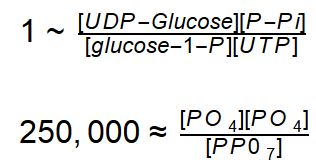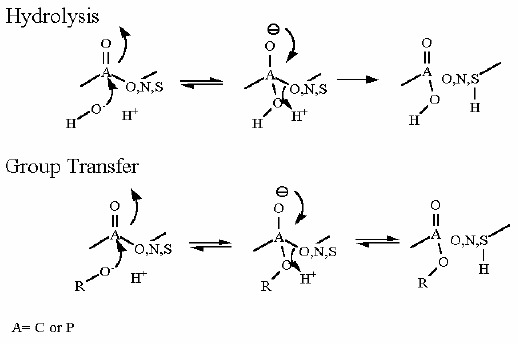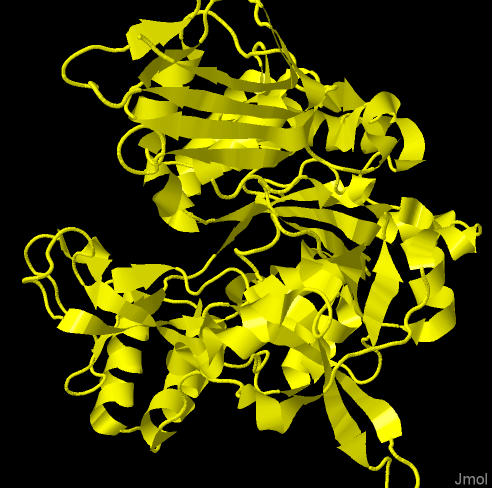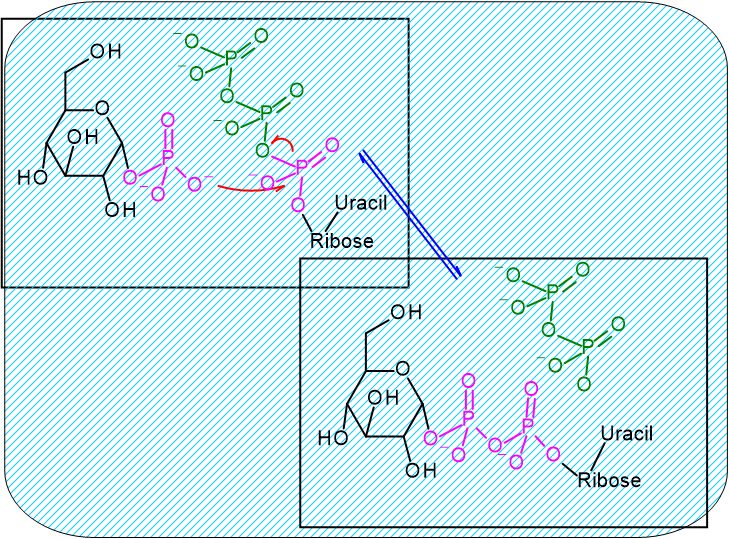|
Enzyme Name |
UDP-Glucose Pyrophosporylase | |
Reaction Catalyzed |
Group Transfer of glucose-1-Phosphate to UMP - with pyrophosphate "leaving"
| |
Reaction Type |
group Transfer Reaction | |
Pathway Involvement |
Glycogen Synthesis |
|
Cofactors/Cosubstrates |
None | |
|
Rationale |
From the phophosglucomutase page we understand that C1 of glucose must have a group on it other than just an -OH. This is solely to avoid doing a condensation reaction as we lengthen the polymer. But we also found out that the ΔG°' of that reaction is about zero and therefore we need to make the reaction go toward products more. The reaction catatyzed by UDP glucose pyrophosphorylase is an attempt to do just this. But wait ... look at the ΔG°' of this reaction. It too is about zero. so it does not appear to help at all. the [product]/[substrate] ratio gets no better with this than it did before Where does the driving force come from?This is where the pyrophosphate comes in. There is a separate enzyme called pyrohosphorylase whose function is to hydrolyze pyrophosphate into 2 phosphates. this latter reaction has a ΔG°' ≈ -31 kJ/M. (about the same as ATP hydrolysis). This reaction lowers the concentration of pyrophosphate thus driving the UDP transfer reaction forward by keeping the ΔG (current conditions) negative. PPO7 → PO4 + PO4 ΔG°' = -31 kJ/MHow Many ATP equivalents are consumed in this reactionAt first glance it appears that only one ATP equivalent (UTP in this case) is hydrolyzed. But what happens to the UMP that ultimately results from this? It takes one ATP to turn it from UMP to UDP and another ATP to convert UDP to UTP. 1. ATP + UMP → ADP + UDP2. ATP + UDP → ADP + UTP There for this reaction uses the equivalent of TWO ATP to complete. | |
|
ΔG°' |
≈ 0 kJ/M | |
Keq |
 |
|
Comments |
Starting from standard state and allowing the reaction to come to equilibrium the UDP glucose pyrphosphorylase reaction will come to about equal concentrations of substrates and products. The Standard Free Energy for this reaction does not really favor either direction. HOWEVER... It is coupled to the hydrolysis of pyrophosphate which does have favorable thermodynamics. It is the loss of pyrophosphate that drives the desired reaction forward to UDP glucose.
| |
|
Mechanism for Chemistry |
 | |
Mechanism for Enzyme |
Hover your mouse over a step to reveal a description | |
|
Picture of Enzyme with substrate |
 |
|
|
Click an atom to diplay it's identity here | |
|
Messages about the currently highlighted features |


